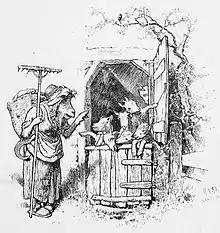The Wolf and the Seven Young Goats
"The Wolf and the Seven Young Goats" (German: Der Wolf und die sieben jungen Geißlein) is a fairy tale collected by the Brothers Grimm and published in Grimm's Fairy Tales (KHM 5). It is of Aarne-Thompson type 123 "The Wolf and the Kids".[1]
| The Wolf and the Seven Young Goats | |
|---|---|
 Illustration by Hermann Vogel | |
| Folk tale | |
| Name | The Wolf and the Seven Young Goats |
| Aarne–Thompson grouping | ATU 123 |
| Country | Germany |
| Published in | Grimm's Fairy Tales |
Origin
The story was published by the Brothers Grimm in the first edition of Kinder- und Hausmärchen in 1812. Their source was the Hassenpflug family from Hanau.[2] A similar tale, The wolf and the kids, has been told in the Middle East and parts of Europe, and probably originated in the first century.[3]
Synopsis
A mother goat leaves her seven children at home while she ventures into the forest to find food. Before she leaves, she warns her young about the wolf who will try to sneak into the house and gobble them up. He will pretend to be their mother and convince the kids to open the door. The young children will be able to recognize their true mother by her white feet and sweet voice.
The mother goat leaves and the seven kids stay in the house. Before long, they hear a voice at the door that says "Let me in children, your mother has something for each and every one of you." It was the wolf, whose gruff voice betrays him and the kids do not let him in. The wolf goes to a marketplace, store, or pharmacy and steals some honey, medicine or chalk, to soften his voice. A little while later, the kids hear another voice at the door: "Let me in children, your mother has something for each and every one of you." This time the voice is high and sweet like their mother's. They are about to let him in when the youngest kid looks under the crack in the door and notices the wolf's big, black feet. They refuse to open the door, and the wolf goes away again.
The wolf goes to the bakery or mill and steals some flour, smearing it all over his coat, turning his black feet white. He returns to the children's house, and says "Let me in children, your mother has something for each and every one of you." The kids see his white feet and hear his sweet voice, so they open the door. The wolf jumps into the house and gobbles up six of the kids. The youngest child hides from the wolf in the grandfather clock and does not get eaten.
Later that day, the mother goat returns home from the forest. She is distraught to find the door wide open and all but one of her children missing. She looks around and sees the wolf, fast asleep under a tree. He has eaten so much, he cannot move. The mother goat calls to her youngest child to quickly get her a pair of scissors, a needle and some thread. She cuts open the wolf's belly and the six children spring out miraculously unharmed. They fill the wolf's belly with rocks, and the mother sews it back up again. When the wolf wakes up, he is very thirsty. He goes to the river to drink, but being so heavy he falls in and drowns under the weight of the rocks. All the children feel great to find themselves safe. The family lives happily ever after.
Analysis
The tale resembles "The Three Little Pigs" and the rescue of the kids from the wolf's belly and his punishment by filling him with stones is comparable to the rescue and revenge of Little Red Cap against the wolf (Aarne-Thompson type 333).[4]
Variants
"The She-Goat, the Kid, and the Wolf" is a variant by Aesop.[5]
Marie de France included a version, "The Wolf, the Goat, and the Kid," in her collection, Esope.[6]
The thirty-third story in Der Edelstein by Ulrich Boner is a variant.[7]
A Romanian variant, “Der alte Mann und der Wolf,” ("The Old Man and the Wolf") was published by Heinrich von Wlislocki. [8]
See also
References
- Uther, Hans-Jorg (2004). The Types of International Folktales: A Classification and a Bibliography. Helsinki: Suomalainen Tiedeakatemia Academia Scientiarum Fennica. pp. 94–95.
- Zipes, Jack (1988). The Complete Fairy Tales of the Brothers Grimm: Volume I. New York: Bantam Books. p. 404.
- Boyle, Alan (November 13, 2013). "Such deep roots you have: How Little Red Riding Hood's tale evolved". NBC News. NBC News. Retrieved 7 June 2020.
- Ashliman, D.L. "The Wolf and the Seven Young Kids". The Grimm Brothers' Children's and Household Tales (Grimms' Fairy Tales) compiled, translated, and classified by D. L. Ashliman. University of Pittsburgh. Retrieved 26 September 2023.
- Gibbs, Laura (2002). Aesop's Fables. New York: Oxford University Press.
- Martin, Mary Lou (1984). The Fables of Marie de France: An English Translation. Birmingham: Summa Publications Inc. p. 225.
- Uther, Hans-Jorg (2004). The Types of International Folktales: A Classification and a Bibliography. Helsinki: Suomalainen Tiedeakatemia Academia Scientiarum Fennica. pp. 94–95.
- von Wlislocki, Heinrich (1886). Märchen und Sagen der transsilvanischen Zigeuner. Berlin: Nicolaische Verlags-Buchhandlung. pp. 130–131.
External links
- (
 Media related to The Wolf and the Seven Young Kids at Wikimedia Commons
Media related to The Wolf and the Seven Young Kids at Wikimedia Commons  The full text of The Wolf and the Seven Little Kids at Wikisource
The full text of The Wolf and the Seven Little Kids at Wikisource- The complete set of Grimms' Fairy Tales, including The Wolf and the Seven Young Goats at Standard Ebooks